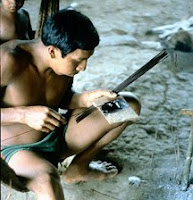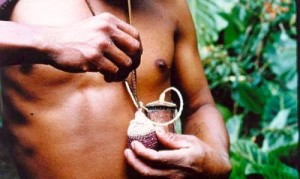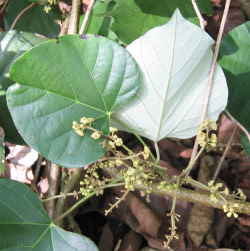Very few indigenous peoples of the Upper Amazon hunt with blowguns any more. The weapon of choice is a 16-gauge shotgun. In North America, we tend to use 20-gauge shotguns for birds and 12-gauge for larger game; the 16-gauge is, in fact, an excellent all-around shotgun, useful for hunting medium-size jungle game — tapir, capybara, agouti, peccary, monkey.
 |
But there is a price. Hunting with a shotgun may be too efficient, making it easy to overhunt particular areas. Perhaps more important, it makes indigenous people dependent on manufactured goods: they cannot make, but rather must buy, shotgun shells.
Hunting with a blowgun and curare-tipped darts was an efficient way to put food on the table; skilled hunters could even bring down small birds. The key, of course, was curare, arrow poison, just as the key to fishing remains barbasco, fish poison. Sticking a dart in a wild pig gives you an angry pig; sticking a curare-tipped dart in a wild pig gives you pork roast.
Historically, there have been two primary types of curare used in the Amazon, which Europeans named, not after their ingredients, which were a mystery, but after the three types of containers in which they were stored. Tube curare, stored in hollow bamboo tubes, was used primarily in western Amazonia — meaning Perú, Ecuador, and western Brazil — and was made from the vine Chondrodendron tomentosum. Calabash curare, stored in small gourds, and pot curare, stored in small clay pots, was used primarily in eastern Amazonia — meaning Colombia, Venezuela, and Guiana — and was made from Strychnos guianensis.
 |
These arrow poisons were usually complex mixtures, incorporating not only the primary active ingredient but also other plants, as well as snake venom, frog venom, or venomous ants — as many as thirty ingredients, which varied from group to group. The recipe was often kept as a commercial secret, in order to maintain regional monopolies. The mixture of bark and stems was pounded, boiled in water for about two days, and then strained and evaporated to become a dark, heavy, viscid paste with a very bitter taste. Additional plant material might be mixed in to make the preparation more glutinous, and thus stick more readily to blowgun darts or arrows.
As we have discussed before, plants of the Strychnos genus contain strychnine, a convulsant poison, which increases the reflex irritability of the spinal cord, resulting in a loss of normal inhibition of the body’s motor cells, in turn causing severe contractions of the muscles. Death is caused by asphyxia from continuous spasms of the respiratory muscles.
On the other hand, the primary active alkaloids in Chondrodendron tomentosum are curarine and tubocurarine — the tubo- prefix is from storing the curare in bamboo tubes — which interfere with the activity of the neurotransmitter acetylcholine, blocking nerve impulses at the neuromuscular junction. The result is the opposite of strychnine; rather than muscle contraction, tubocurarine produces limp relaxation of voluntary muscles. Death is caused by asphyxia because the respiratory muscles cease to operate.
 |
A person hit by a poison dart of this sort is awake, aware, susceptible to pain, but unable to move. If breathing is supported by artificial respiration, recovery is complete in about thirty minutes, when the alkaloid has been metabolized.
These curare alkaloids have two significant advantages for hunters. Since they result in muscle relaxation, animals hit by the darts fall out of trees onto the ground. Moreover, because these curare alkaloids are absorbed very slowly from the intestine, animals kiled by the poison darts can be eaten with impunity. The muscle-relaxing effect begins almost immediately upon hitting the bloodstream, but death from respiratory arrest can take a few minutes for birds and small prey and up to twenty minutes for larger mammals, such as tapirs. When I was staying among the formerly head-hunting Shapra in the borderlands between Perú and Ecuador, I was told that it can take fifteen or twenty darts to bring down a human being.
 |
The strength of a batch of curare can be tested in a number of ways — for example, by counting the number of times a frog can jump after being pricked, or how many trees a monkey can leap to after being hit. One-tree curare is very potent; three-tree curare can be used to take down live animals to be kept in captivity.
Biomedicine has been profoundly interested in the neuromuscular properties of the curare alkaloids. Tubocurarine has been studied for its use as a muscle relaxant in surgery, reducing the need for deep anesthesia, and as an aid to intubation or ventilation. A number of synthetic analogues have been developed, including succinylcholine and pancuronium, both of which — irony alert — have been used in executions by lethal injection.

- Previous Post: Marshall Arisman, Shaman
- Next Post: The Ayahuasca Patent Case
- More Articles Related to: Indigenous Culture, Plant Medicine, The Amazon


